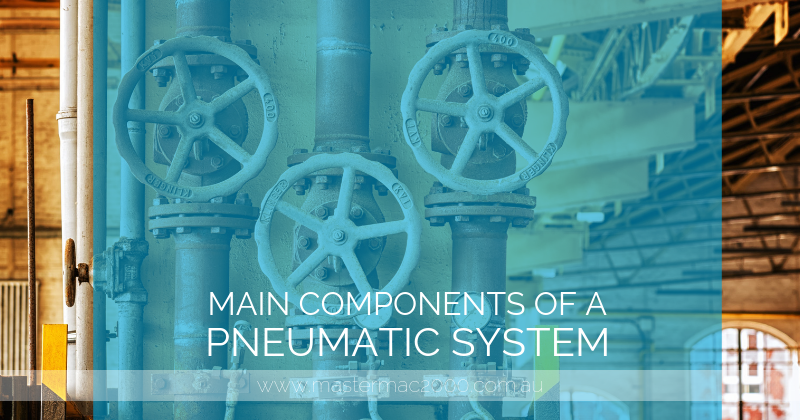Main Components of a Pneumatic System

All pneumatic systems use compressed air to operate and move parts or actuators. These systems like pneumatic valves range from simple air-driven pistons to multiple actuator mining operations. They commonly use compressed atmospheric air because of the abundance and inexpensiveness. Due to their ease of use, quietness and cost-efficiency, they are generally preferred over liquid-using hydraulic systems.
Here are the common parts of a pneumatic system:
Check Valves. These are one-way valves that are installed to the hose, which connects the compressor to the buffer tank. They let the compressed air gather in the buffer tanks, but prevent backflow into the compressor tank.
Compressor. It is a mechanical device that increases the pressure of air by reducing its volume. This is a pump powered by gas or electricity. It compresses the air to a higher PSI (pounds per square inch). Compressors have a tank connected to store the air before it’s released into the pneumatic track. An air compressor is a specific type of gas compressor.
Regulators and gauges. These are equipment that is connected to the compressor or compressor tank. To release air into the pneumatic track, the regulator is electrically or mechanically triggered. Gauges are also electric or mechanic measuring instruments. They let the computer system or operator to regulate and check the PSI of the air inside the compressor.
Accumulator or buffer tank. Buffer tanks are secondary storage units for the compressed air that came from the compressor. They are storing the high-PSI compressed air for the pneumatic actuators. These tanks help in preventing irregular airflow surges in the actuators, allowing the compressor cycle to maximise its shutoff timing. They also allow the compressor to be in the exact distance from the actuators in projects.
Feed lines. These are hoses that move the pressurised air through the pneumatic system. The largest diameter hoses are installed to handle the PSI. These large hoses allow the pressurised air to travel faster, eliminating the airflow backups.
Actuators. These are the components of the pneumatic system that do the hard work. Many types of actuators are powered by pressurised air. The most frequently used are cylinder and plunge. The pressurised air is released into the cylinder to make a piston move forward as the air is forced to the chamber.
These are some of the main components of a pneumatic system. To fully understand the system, you need to know how every component works. Knowing their specific functions will help in preventing problems during work.
If you need pneumatic valves, Mastermac2000 can provide you quality pneumatic products. Contact us now!

About MasterMac2000: Your Trusted Pneumatic & Process Automation Partner.
LEADING THE INDUSTRY: Established in 1989, MasterMac2000 has grown to become one of Australia's largest privately owned pneumatic and process automation companies. We stock top-quality brands like Univer, Mack, Tolomatic, Mac, Piab, American, and Rotoflux in Brisbane.
SERVING QLD & NORTHERN NSW: We proudly service Queensland and Northern New South Wales for all your pneumatic and process equipment needs. Our mission is to provide the best pre and post-sales support while actively expanding our client base.
SOURCING HARD-TO-FIND PARTS: Not only do we stock quality components, but we also excel at sourcing those elusive, hard-to-find parts. With our extensive database and global network of contacts, getting the parts you require is as easy as a call to our highly skilled, professional sales team.
DEDICATED TO YOUR SUCCESS:
- Decades of expertise in pneumatics & process automation
- Carefully curated selection of world-class brands
- Exceptional sourcing capabilities for speciality parts
- Knowledgeable sales staff dedicated to finding solutions
- Unwavering commitment to customer service excellence
About The Author
Stuart Havill
Stuart Havill is the owner and manager of MasterMac2000, Queensland's largest privately owned pneumatic and process valve company.
With his early working career as a maintenance fitter for Boral in 1992, Stuart has spent his life in the field of pneumatics and process equipment. He gained extensive experience in plant design, maintenance, repairs, fabrication, and site management.
In 1996, he transitioned to a pneumatic sales technician role at MasterMac2000, where he excelled in key account management, providing cost-effective solutions, and managing a sales team of 9 employees.
Since 2002, Stuart has been the manager at MasterMac2000, overseeing the company's growth and establishing it as a leader in pneumatic automation and process valve engineering. His expertise spans customer training, CRM setup, industrial compressor sizing and installation, and turn-key project management.
Under Stuart's leadership, MasterMac2000 has been servicing the industry since 1988, with 5 full-time sales representatives covering northern rivers NSW, Queensland, Northern Territory, and PNG. The company prides itself on providing the best-priced solutions to all customers in the marketplace.
View Stuart’s LinkedIn profile to learn more about his expertise in pneumatics and process equipment.